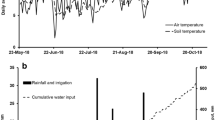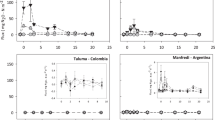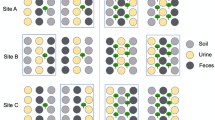Abstract
Purpose
In grazed pastures, nitrous oxide (N2O), a powerful greenhouse gas and an ozone depletion substance, is mostly emitted from animal excreta, particularly animal urine-N returned to the soil during grazing. We conducted a series of four field lysimeter and plot experiments to assess the potential of using gibberellic acid (GA) and/or alternative pastures or forage crops to mitigate N2O emissions from outdoor dairy farming systems.
Materials and methods
Pasture and forage plants assessed in the experiments included Italian ryegrass (Lolium multiflorum L.), lucerne (Medicago sativa L.), diverse pastures (including plantain (Plantago lanceolata L.), chicory (Cichorium intybus L.), perennial ryegrass (Lolium perenne L.) and white clover (Trifolium repens L.)), fodder beet (Beta vulgaris L.), kale (Brassica oleracea L.), as well as the standard perennial ryegrass and white clover (RG/WC) pastures. N2O was determined using a standard static chamber method in the field either on top of lysimeters or field plots.
Results and discussion
The results showed that the application of GA to urine-treated lysimeters with Italian ryegrass, lucerne or RG/WC pastures did not result in lower N2O emissions. However, the use of diverse pastures which included plantain with a lower urine-N loading rate at about 500 kg N ha−1 significantly decreased N2O emissions by 46 % compared with standard RG/WC with a urine-N loading rate at 700 kg N ha−1. However, when urine-N was applied at the same rates (at 500 or 700 kg N ha−1), the N2O emissions were similar between the diverse and the standard RG/WC pastures. This would indicate that it is the N-loading rate in the urine from the different pastures that determines the N2O emissions from different pastures or forages, rather than the plants per se. The N2O emissions from cow urine from fodder beet were 39 % lower than from kale with the same urine-N application rate (300 kg N ha−1).
Conclusions
These results suggest that N2O emissions can potentially be reduced by incorporating diverse pastures and fodder beet into the grazed pasture farm system. Further studies on possible mechanisms for the lower N2O emissions from the different pastures or forages would be useful.





Similar content being viewed by others
References
Abalos D, Gerlinde GB, Deyn BD, Kuyper TW, Groenigen JWV (2014) Plant species identity surpasses species richness as a key driver of N2O emissions from grassland. Glob Chang Biol 20:265–275
Bending GD, Lincoln SD (2000) Inhibition of soil nitrifying bacteria communities and their activities by glucosinolate hydrolysis products. Soil Biol Biochem 32:1261–1269
Cameron KC, Smith NP, McLay CDA, Fraser PM, McPherson RJ, Harrison DF, Harbottle P (1992) Lysimeters without edge-flow: an improved design and sampling procedure. Soil Sci Soc Am J 56:1625–1628
Cameron KC, Di HJ, Moir J (2013) Nitrogen losses from the soil/plant system: a review. Annals of Appl Biol 162:145–173
de Klein CAM, Barton L, Sherlock RR, Li Z, Littlejohn RP (2003) Estimating a nitrous oxide emission factor for animal urine from some New Zealand pastoral soils. Aust J Soil Res 41(3):381–399
de Klein CAM, Smith LC, Monaghan RM (2006) Restricted autumn grazing to reduce nitrous oxide emissions from dairy pastures in Southland, New Zealand. Agric Ecosys Environ 112:192–199
de Klein CAM, Letica SA, Macfie PI (2014) Evaluating the effects of dicyandiamide (DCD) on nitrogen cycling and dry matter production in a 3-year trial on a dairy pasture in South Otago, New Zealand. NZ J Ag Res 57:316–331
Di HJ, Cameron KC (2002a) The use of a nitrification inhibitor, dicyandiamide (DCD), to reduce nitrate leaching and nitrous oxide emissions in a simulated grazed and irrigated grassland. Soil Use Manage 18:395–403
Di HJ, Cameron KC (2002b) Nitrate leaching in temperate agroecosystems: sources, factors and mitigating strategies. Nutr Cycl Agroecosys 46:237–256
Di HJ, Cameron KC (2003) Mitigation of nitrous oxide emissions in spray-irrigated grazed grassland by treating the soil with dicyandiamide, a nitrification inhibitor. Soil Use Manage 19:184–290
Di HJ, Cameron KC (2006) Nitrous oxide emissions from two dairy pasture soils as affected by different rates of a fine particle suspension nitrification inhibitor, dicyandiamide (DCD). Biol Fert Soils 42:472–480
Di HJ, Cameron KC (2016) Inhibition of nitrification to mitigate nitrate leaching and nitrous oxide emissions in grazed grassland: a review. J Soils Sediments 16:1401–1420
Di HJ, Cameron KC, Milne J, Drewry JJ, Smith NP, Hendry T, Moore S, Reijnen B (2001) A mechanical hoof for simulating animal treading under controlled conditions. NZ J Agric Res 43:111–116
Di HJ, Cameron KC, Sherlock RR (2007) Comparison of the effectiveness of a nitrification inhibitor, dicyandiamide (DCD), in reducing nitrous oxide emissions in four different soils under different climatic and management conditions. Soil Use Manage 23:1–9
Edwards GR, de Ruiter JM, Dalley DE, Pinxterhuis JB, Cameron KC, Bryant RH, Di HJ, Malcolm BJ, Chapman DF (2014a) Dry matter intake, body condition score change and urine nitrogen concentration of dairy cows grazing fodder beet, kale and kale-oat winter systems in winter. Proc NZ Grassland Assoc 76:81–88
Edwards GR, de Ruiter JM, Dalley DE, Pinxterhuis JB, Cameron KC, Bryant RH, Di HJ, Malcolm BJ, Chapman DF (2014b) Urinary nitrogen concentration of cows grazing fodder beet, kale and kale-oat forage systems in winter. Aust Dairy Sci Symp Waikato, New Zealand, Nov 19–21(2014):144–147
Edwards GR, Bryant R, Smith N, Hague H, Taylor S, Ferris A, Farrell L (2015) Milk production and urination behaviour of dairy cows grazing diverse and simple pastures. Proc NZ Soc An Prod 75:79–83
FAO (2006) Livestock’s long shadow, environmental issues and options. Food and Agriculture Organization of the United Nations, Rome
Ghani A, Ledgard S, Wyatt J, Catto W (2014) Agronomic assessment of gibberellic acid and cytokinin plant growth regulators with nitrogen fertiliser application for increasing dry matter production and reducing the environmental footprint. Proc NZ Grassland Assoc 76:177–182
Gilsanz C, Báez D, Misselbrook TH, Dhanoa MS, Cárdenas LM (2016) Development of emission factors and efficiency of two nitrification inhibitors, DCD and DMPP. Agric Ecosys Environ 216:1–8
Haynes RJ, Williams PH (1993) Nutrient cycling and soil fertility in the grazed pasture ecosystem. Adv Agron 49:119–199
Hutchinson GL, Mosier AR (1981) Improved soil cover method for field measurement of nitrous oxide fluxes. Soil Sci Soc Am J 45:311–316
Jarvis SC, Scholefield D, Pain B (1995) Nitrogen cycling in grazing systems. In: Bacon PE (ed) Nitrogen fertilization in the environment. Marcel Dekker, New York, pp 381–419
Luo J, Ledgard SF, Lindsey SB (2008) A test of a winter farm management option for mitigating nitrous oxide emissions from a dairy farm. Soil Use Manage 24:121–130
Luo J, Sun XZ, Pacheco D, Ledgard SF, Lindsey SB, Hoogendoorn CJ, Wise B, Watkins NL (2015) Nitrous oxide emission factors for urine and dung from sheep fed either fresh forage rape (Brassica napus L.) or fresh perennial ryegrass (Lolium perenne L.). Animal 9:534–543
Malcolm BJ, Cameron KC, Di HJ, Edwards GR, Moir JL (2014) The effect of four different pasture species compositions on nitrate leaching losses under high N loading. Soil Use Manage 30:58–68
MFE (2015) New Zealand's greenhouse gas inventory 1990–2013. Ministry for the Environment, Wellington
Selbie DR, Buckthought LE, Shepherd MA (2014a) The challenge of the urine patch for managing nitrogen in grazed pasture systems. Adv Agron 129:229–292
Selbie DR, Cameron KC, Di HJ, Moir JL, Lanigan G, Richards KG (2014b) The effect of urinary nitrogen loading rate and dicyandiamide nitrification inhibitor on nitrous oxide emissions from a temperate grassland soil. J Agric Sci Cam 152:S159–S171
Soil Survey Staff (1998) Keys to soil taxonomy. 8th edition. Department of Agriculture, Washington DC, United States, US Government Print Office
Subbarao GV, Sahrawat KL, Nakahara K, Ishikawa T, Kishii M, Rao IM, Hash CT, George TS, Rao PS, Nardi P, Bonnett D, Berry W, Suenaga K, Lata JC (2012) Biological nitrification inhibition—a novel strategy to regulate nitrification in agricultural systems. Adv Agron 114:249–302
Totty VK, Greenwood SL, Bryant RH, Edwards GR (2013) Nitrogen partitioning and milk production of dairy cows grazing simple and diverse pastures. J Dairy Sci 96:141–149
van Rossum MH, Bryant RH, Edwards GR (2013) Response of simple grass-white clover and multi-species pastures to gibberellic acid or nitrogen fertiliser in autumn. Proc NZ Grassland Assoc 75:145–150
Whitehead D, Edwards GR (2015) Assessment of the application of gibberellins to increase productivity and reduce nitrous oxide emissions in grazed grassland. Agric Ecosys Environ 207:40–50
Acknowledgments
This work was funded by the New Zealand Agricultural Greenhouse Gas Research Centre (NZAGRC) and Ministry for Primary Industries (MPI). Permission for access to allied research programmes funded by the Pastoral 21 Consortium (including The Ministry of Business, Innovation and Employment (MBIE), Fonterra, DairyNZ, and Beef and Lamb New Zealand), DCANZ, and the research of Forages for Reduced Nitrate Leaching funded by MBIE and DairyNZ is gratefully acknowledged. We would like to thank Trevor Hendry, Roger Atkinson, Nigel Beale and Manjula Premaratne for technical support.
Author information
Authors and Affiliations
Corresponding author
Additional information
Responsible editor: Zhihong Xu
Rights and permissions
About this article
Cite this article
Di, H.J., Cameron, K.C., Podolyan, A. et al. The potential of using alternative pastures, forage crops and gibberellic acid to mitigate nitrous oxide emissions. J Soils Sediments 16, 2252–2262 (2016). https://doi.org/10.1007/s11368-016-1442-1
Received:
Accepted:
Published:
Issue Date:
DOI: https://doi.org/10.1007/s11368-016-1442-1




